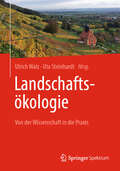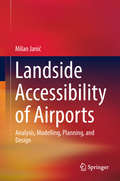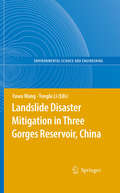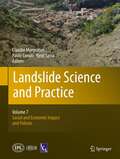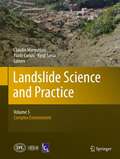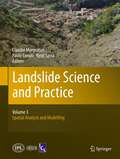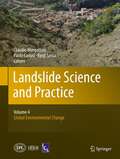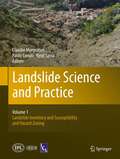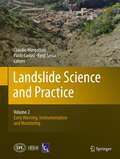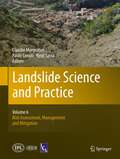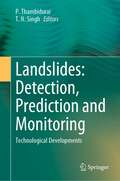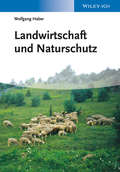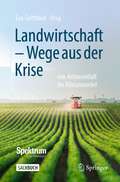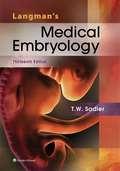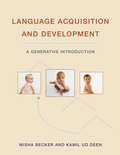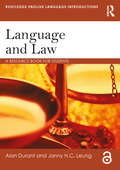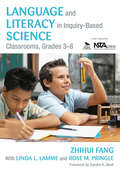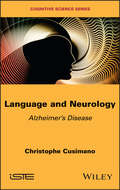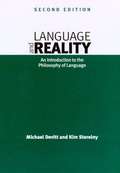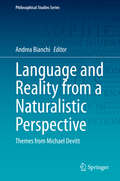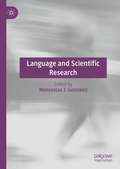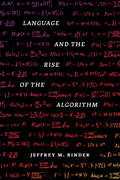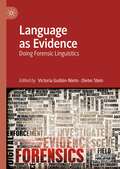- Table View
- List View
Landschaftsökologie: Von der Wissenschaft in die Praxis
by Ulrich Walz Uta SteinhardtLandschaft ist ein wichtiger Schlüssel zur Nachhaltigkeit. Aktuelle Krisen wie der Biodiversitätsverlust und der Klimawandel verlangen nach integrativen Betrachtungsweisen und Lösungsansätzen zu unserem Umgang mit Landschaft, den wir grundlegend ändern müssen. Landschaftsökologie will genau das: fach- und sektorübergreifend analysieren und Lösungen aufzeigen. „Der Blick auf’s Ganze“, auf Landschaft, die mehr ist als die Summe ihrer Teile, zeichnet die landschaftsökologische Arbeitsweise aus. Darum geht es auch in diesem Buch: natur-, sozial- und kulturwissenschaftliche sowie planerische Sichtweisen auf die Probleme unserer Zeit aufzuzeigen und zu verbinden. Landschaftsökologischen Institutionen aus Deutschland geben Einblicke in die aktuell von ihnen bearbeiteten Themen und zeigen so die Leistungsfähigkeit des Faches insgesamt auf. Ziel des Werkes ist es, die aktuelle Bandbreite landschaftsökologischer Forschung anhand zahlreicher Beispiele zu verdeutlichen und dieFachkolleg_innen und Studierende der Landschaftsökologie und verwandter Fächer wie Geographie, Umweltwissenschaften, Biologie, Ökologie, etc. zu erreichen.
Landside Accessibility of Airports: Analysis, Modelling, Planning, And Design
by Milan JanićThis book covers the analysis, modelling, planning, and design of airport landside access modes and their systems. It elaborates on the issues and related problems of airport landside accessibility in an innovative, comprehensive and systematic way. In addition to the general concept of accessibility, the book addresses the analysis and modelling of infrastructure-related, technological, operational, economic, social and environmental performance of road- and rail-based transport systems, as well as the core principles of their planning and design. The book provides guidelines on the modelling, planning, and design of airport landside access modes and their systems, which will contribute to the overall sustainable development of airports. Its main features are: presents a multidimensional examination of performance for specific airport landside access modes and their systems; pursues a qualitative and quantitative approach to developing performance indicators for estimating the sustainability of airport landside access modes and their systems; includes illustrative cases of airport landside accessibility, and numerical examples as exercises for assessing performance using the systems’ indicators. As such, the book offers a valuable source of information for all practitioners involved in analysing, planning and designing more environmentally friendly airport access modes and systems, and who want to learn how to overcome the issues and problems surrounding landside accessibility. It will also benefit students studying the analysis and modelling of transportation systems, and researchers seeking to promote improved sustainability at airports.
Landslide Disaster Mitigation in Three Gorges Reservoir, China
by Tonglu Li Fawu WangThis book presents the research results on landslide disaster mitigation in Three Gorges Reservoir, China. It consists of three parts. (1) Regional properties of landslides in this area, (2) Case studies about some typical landslides, and (3) New methodologies applied in this area. It provides useful information to academics, practitioners, and university students working on landslide disaster mitigation, especially for large engineering projects. This book can also be used as an information source for geo-hazards in the Three Gorges Reservoir Area.
Landslide Ecology
by Lawrence R. Walker Aaron B. ShielsDespite their often dangerous and unpredictable nature, landslides provide fascinating templates for studying how soil organisms, plants and animals respond to such destruction. The emerging field of landslide ecology helps us understand these responses, aiding slope stabilisation and restoration and contributing to the progress made in geological approaches to landslide prediction and mitigation. Summarising the growing body of literature on the ecological consequences of landslides, this book provides a framework for the promotion of ecological tools in predicting, stabilising, and restoring biodiversity to landslide scars at both local and landscape scales. It explores nutrient cycling; soil development; and how soil organisms disperse, colonise and interact in what is often an inhospitable environment. Recognising the role that these processes play in providing solutions to the problem of unstable slopes, the authors present ecological approaches as useful, economical and resilient supplements to landslide management.
Landslide Science and Practice: Social and Economic Impact and Policies
by Claudio Margottini Kyoji Sassa Paolo CanutiThis book contains peer-reviewed papers from the Second World Landslide Forum, organised by the International Consortium on Landslides (ICL), that took place in September 2011. The entire material from the conference has been split into seven volumes, this one is the seventh: 1. Landslide Inventory and Susceptibility and Hazard Zoning, 2. Early Warning, Instrumentation and Monitoring, 3. Spatial Analysis and Modelling, 4. Global Environmental Change, 5. Complex Environment, 6. Risk Assessment, Management and Mitigation, 7. Social and Economic Impact and Policies.
Landslide Science and Practice: Complex Environment
by Claudio Margottini Kyoji Sassa Paolo CanutiThis book contains peer-reviewed papers from the Second World Landslide Forum, organised by the International Consortium on Landslides (ICL), that took place in September 2011. The entire material from the conference has been split into seven volumes, this one is the fifth: 1. Landslide Inventory and Susceptibility and Hazard Zoning, 2. Early Warning, Instrumentation and Monitoring, 3. Spatial Analysis and Modelling, 4. Global Environmental Change, 5. Complex Environment, 6. Risk Assessment, Management and Mitigation, 7. Social and Economic Impact and Policies.
Landslide Science and Practice: Spatial Analysis and Modelling
by Claudio Margottini Kyoji Sassa Paolo CanutiThis book contains peer-reviewed papers from the Second World Landslide Forum, organised by the International Consortium on Landslides (ICL), that took place in September 2011. The entire material from the conference has been split into seven volumes, this one is the seventh: 1. Landslide Inventory and Susceptibility and Hazard Zoning, 2. Early Warning, Instrumentation and Monitoring, 3. Spatial Analysis and Modelling, 4. Global Environmental Change, 5. Complex Environment, 6. Risk Assessment, Management and Mitigation, 7. Social and Economic Impact and Policies.
Landslide Science and Practice: Global Environmental Change
by Claudio Margottini Kyoji Sassa Paolo CanutiThis book contains peer-reviewed papers from the Second World Landslide Forum, organised by the International Consortium on Landslides (ICL), that took place in September 2011. The entire material from the conference has been split into seven volumes, this one is the fourth: 1. Landslide Inventory and Susceptibility and Hazard Zoning, 2. Early Warning, Instrumentation and Monitoring, 3. Spatial Analysis and Modelling, 4. Global Environmental Change, 5. Complex Environment, 6. Risk Assessment, Management and Mitigation, 7. Social and Economic Impact and Policies.
Landslide Science and Practice: Landslide Inventory and Susceptibility and Hazard Zoning
by Claudio Margottini Kyoji Sassa Paolo CanutiThis book contains peer-reviewed papers from the Second World Landslide Forum, organised by the International Consortium on Landslides (ICL), that took place in September 2011. The entire material from the conference has been split into seven volumes, this one is the first: 1. Landslide Inventory and Susceptibility and Hazard Zoning, 2. Early Warning, Instrumentation and Monitoring, 3. Spatial Analysis and Modelling, 4. Global Environmental Change, 5. Complex Environment, 6. Risk Assessment, Management and Mitigation, 7. Social and Economic Impact and Policies.
Landslide Science and Practice: Early Warning, Instrumentation and Monitoring
by Claudio Margottini Kyoji Sassa Paolo CanutiThis book contains peer-reviewed papers from the Second World Landslide Forum, organised by the International Consortium on Landslides (ICL), that took place in September 2011. The entire material from the conference has been split into seven volumes, this one is the second: 1. Landslide Inventory and Susceptibility and Hazard Zoning, 2. Early Warning, Instrumentation and Monitoring, 3. Spatial Analysis and Modelling, 4. Global Environmental Change, 5. Complex Environment, 6. Risk Assessment, Management and Mitigation, 7. Social and Economic Impact and Policies.
Landslide Science and Practice: Risk Assessment, Management and Mitigation
by Claudio Margottini Kyoji Sassa Paolo CanutiThis book contains peer-reviewed papers from the Second World Landslide Forum, organised by the International Consortium on Landslides (ICL), that took place in September 2011. The entire material from the conference has been split into seven volumes, this one is the sixth: 1. Landslide Inventory and Susceptibility and Hazard Zoning, 2. Early Warning, Instrumentation and Monitoring, 3. Spatial Analysis and Modelling, 4. Global Environmental Change, 5. Complex Environment, 6. Risk Assessment, Management and Mitigation, 7. Social and Economic Impact and Policies.
Landslides: Technological Developments
by P. Thambidurai T. N. SinghThis book intends to decipher the knowledge in the advancement of understanding, detecting, predicting, and monitoring landslides. The number of massive landslides and the damages they cause has increased across the globe in recent times. It is one of the most devastating natural hazards that cause widespread damage to habitat on a local, regional, and global scale. International experts provide their experience in landslide research and practice to help stakeholders mitigate and predict potential landslides. The book comprises chapters on: Dynamics, mechanisms, and processes of landslides; Geological, geotechnical, hydrological, and geophysical modelling for landslides; Mapping and assessment of hazard, vulnerability, and risk associated with landslides; Monitoring and early warning of landslides; Application of remote sensing and GIS techniques in monitoring and assessment of landslides. The book will be of interest to researchers, practitioners, and decision-makers in adapting suitable modern techniques for landslide study.
Landwirtschaft und Naturschutz
by Wolfgang HaberProfessor Wolfgang Haber ist Vorkämpfer und seit vier Jahrzehnten wichtigster Exponent des Natur- und Landschaftsschutzes in Deutschland. In dieser umfassenden und aktuellen Übersicht setzt er sich kritisch mit der Wechselbeziehung zwischen landwirtschaftlicher Nutzung und dem Schutz von ländlichen Lebensräumen auseinander. Getreu seinem Credo, dass es eine nicht umweltbelastende Landwirtschaft nicht geben kann, entwirft Haber das Leitbild einer multifunktionalen Landwirtschaft – mit einer differenzierten Boden- und Landnutzung, die den Zielen der Erzeugung hochwertiger und sicherer Nahrung ebenso verpflichtet ist wie der Erhaltung der ländlichen Kulturlandschaft und ihrer vielfältigen Biotope. In einem Spannungsbogen vom Beginn der Landwirtschaft im Neolithikum bis hin zur heutigen staatlich gelenkten Agrarindustrie zeichnet er Entwicklungen und Prozesse nach, die unsere heutige Kulturlandschaft geformt haben und analysiert deren Einfluss auf Nachhaltigkeit der Landnutzung, biologische Vielfalt und Leistungsfähigkeit der Ökosysteme von Ackerland, Grünland und Sonderkulturen wie Obst- und Weinbau. Zahlreiche Fallbeispiele aus Deutschland, Österreich und der Schweiz sowie eine Vielzahl von aktuellen Daten runden das Werk ab und liefern wertvolles Material für eine sachliche Auseinandersetzung mit einem Thema, welches völlig zu Recht immer stärker in den öffentlichen Diskurs Eingang findet.
Landwirtschaft - Wege aus der Krise: von Artenvielfalt bis Klimawandel
by Eva GottfriedLandwirtschaft geht uns alle an!Mit immer ertragreicheren Sorten, modernen Düngemitteln und potenten Pestiziden haben wir jahrelang eine intensivierte Landwirtschaft auf Kosten der Natur vorangetrieben. Nun schielen immer mehr Landwirte auf naturnahe, nachhaltige Ansätze. Doch was bedeutet dies für die Agrarwirtschaft? Sind an den Klimawandel angepasste Kulturpflanzen nachhaltig? Und sollen wir diese durch klassische, langwierige Züchtung entwickeln oder ist grüne Gentechnik durch Schnelligkeit im Vorteil? Wie steht es um Patente auf Naturprodukte? Können wir die Agrarwirtschaft in unsere immer größeren Städte integrieren und vielleicht durch Digitalisierung retten? Die im Buch gesammelten Beiträge aus Spektrum der Wissenschaft, Spektrum – die Woche und Spektrum.de bieten vielfältige Ansätze und Denkanstöße mit Blick auf Herausforderungen, Risiken und Möglichkeiten für ein Umlenken in der Landwirtschaft.
Langman’s Medical Embryology, Thirteenth Edition
by T. W. SadlerLangman's Medical Embryology is organized into two parts. The first provides an overview of early development from gametogenesis through the embryonic period. Also included in this section are chapters on placental and fetal development as well as prenatal diagnosis and birth defects. The second part of the text provides a description of the fundamental processes of embryogenesis for each organ system.
Language Acquisition and Development: A Generative Introduction
by Misha Becker Kamil Ud DeenAn introduction to the study of children's language development that provides a uniquely accessible perspective on generative/universal grammar–based approaches.How children acquire language so quickly, easily, and uniformly is one of the great mysteries of the human experience. The theory of Universal Grammar suggests that one reason for the relative ease of early language acquisition is that children are born with a predisposition to create a grammar. This textbook offers an introduction to the study of children's acquisition and development of language from a generative/universal grammar–based theoretical perspective, providing comprehensive coverage of children's acquisition while presenting core concepts crucial to understanding generative linguistics more broadly. After laying the theoretical groundwork, including consideration of alternative frameworks, the book explores the development of the sound system of language—children's perception and production of speech sound; examines how words are learned (lexical semantics) and how words are formed (morphology); investigates sentence structure (syntax), including argument structure, functional structure, and tense; considers such “nontypical” circumstances as acquiring a first language past infancy and early childhood, without the abilities to hear or see, and with certain cognitive disorders; and studies bilingual language acquisition, both simultaneously and in sequence.Each chapter offers a summary section, suggestions for further reading, and exercises designed to test students' understanding of the material and provide opportunities to practice analyzing children's language. Appendixes provide charts of the International Phonetic Alphabet (with links to websites that allow students to listen to the sounds associated with these symbols) and a summary of selected experimental methodologies.
Language and Complex Systems
by William A. Kretzschmar Jr.An understanding of language as a complex system helps us to think differently about linguistics, and helps us to address the impact of linguistic interaction. This book demonstrates how the science of complex systems changes every area of linguistics: how to make a grammar, how to think about the history of language, how language works in the brain, and how it works in social settings. Kretzschmar argues that to construct the best grammars of languages it is necessary to understand the complex system of speech. Each chapter makes specific recommendations for how linguists should manage empirical data in order to form better generalizations about a language and its varieties. The book will be welcomed by students and scholars working in linguistics and English language, especially the study of language variation and the historical development of English.
Language and Law: A resource book for students (Routledge English Language Introductions)
by Alan Durant Janny HC LeungLanguage plays an essential role both in creating law and in governing its implementation. Providing an accessible and comprehensive introduction to this subject, Language and Law: describes the different registers and genres that make up spoken and written legal language and how they develop over time; analyses real-life examples drawn from court cases from different parts of the world, illustrating the varieties of English used in the courtroom by speakers occupying different roles; addresses the challenges presented to our notions of law and regulation by online communication; discusses the complex role of translation in bilingual and multilingual jurisdictions, including Hong Kong and Canada; and provides readings from key scholars in the discipline, including Lawrence Solan, Peter Goodrich, Marianne Constable, David Mellinkoff, and Chris Heffer. With a wide range of activities throughout, this accessible textbook is essential reading for anyone studying language and law or forensic linguistics. Sections A, B, and C of this book are freely available as a downloadable Open Access PDF under a Creative Commons Attribution-Non Commercial-No Derivatives 4.0 license available at http://www.taylorfrancis.com/books/e/9781315436258
Language and Literacy in Inquiry-Based Science Classrooms, Grades 3-8
by Zhihui Fang Linda L. Lamme Rose M. PringleThis hands-on resource offers a wealth of strategies aligned with national science education standards, including sample lessons for integrating reading instruction into inquiry-based science classrooms.
Language and Neurology: Alzheimer's Disease
by Christophe CusimanoThis book questions the relationship and compatibility between current beliefs in neurology and contemporary textual linguistic theories, interpretative semantics and discourse analysis. It begins with a critical examination of the screenings for Alzheimer's type dementia through cognitive testing, particularly screenings where language is used. It then analyzes the various linguistic properties (morphological, syntactic and semantic) of the speech of Alzheimer's patients, which can be troubling for both caregivers and their environment in general. More than a synthesis of critical linguistic reflections, Language and Neurology provokes a fruitful reflection through adjustments suggested by the acquired knowledge of textual semantics.
Language and Reality
by Michael Devitt Kim SterelnyOur philosophical approach remains realist and naturalist and that approach permeates the work.
Language and Reality from a Naturalistic Perspective: Themes from Michael Devitt (Philosophical Studies Series #142)
by Andrea BianchiThis book celebrates the many important contributions to philosophy by one of the leading philosophers in the analytic field, Michael Devitt.It collects seventeen original essays by renowned philosophers from all over the world. They all develop themes from Devitt’s work, thus discussing many fundamental issues in philosophy of linguistics, theory of reference, theory of meaning, methodology, and metaphysics.In a long final chapter, Devitt himself replies to the contributors. In so doing, he further elaborates his views on various of these issues, for example defending his claim (in opposition to Chomskyan orthodoxy) that languages are external rather than internal; his well-known causal theory of reference; his “shocking” idea that meanings can be causal, non-descriptive, modes of presentation; his methodological naturalism; his commitment to scientific realism; and his version of biological essentialism. The volume will appeal to all scholars and students interested in contemporary theoretical analytic philosophy, and will be a must-read for any serious researcher in philosophy of language. It provides a deep insight into the work of one of the most important living philosophers, and will help readers to better understand language and reality from a naturalistic perspective.
Language and Scientific Research
by Wenceslao J. GonzalezThis book analyzes the role of language in scientific research and develops the semantics of science from different angles. The philosophical investigation of the volume is divided into four parts, which covers both basic science and applied science: I) The Problem of Reference and Potentialities of the Language in Science; II) Language and Change in Scientific Research: Evolution and Historicity; III) Scientific Language in the Context of Truth and Fiction; and IV) Language in Mathematics and in Empirical Sciences. Language plays a key role in science: our access to the theoretical, practical or evaluative dimensions of scientific activity begins with the mastery of language, continues with a deepening in the use of language and reaches the level of contribution when it creates new terms or changes them in sense and reference. This reveals the compatibility between objectivity in semantic contents and historicity in the progress of science. This volume is a valuable enrichment to students, academics and other professionals interested in science in all its forms, who seek to deepen the role that language plays in its structure and dynamics.
Language and the Rise of the Algorithm
by Jeffrey M. BinderA wide-ranging history of the algorithm. Bringing together the histories of mathematics, computer science, and linguistic thought, Language and the Rise of the Algorithm reveals how recent developments in artificial intelligence are reopening an issue that troubled mathematicians well before the computer age: How do you draw the line between computational rules and the complexities of making systems comprehensible to people? By attending to this question, we come to see that the modern idea of the algorithm is implicated in a long history of attempts to maintain a disciplinary boundary separating technical knowledge from the languages people speak day to day. Here Jeffrey M. Binder offers a compelling tour of four visions of universal computation that addressed this issue in very different ways: G. W. Leibniz’s calculus ratiocinator; a universal algebra scheme Nicolas de Condorcet designed during the French Revolution; George Boole’s nineteenth-century logic system; and the early programming language ALGOL, short for algorithmic language. These episodes show that symbolic computation has repeatedly become entangled in debates about the nature of communication. Machine learning, in its increasing dependence on words, erodes the line between technical and everyday language, revealing the urgent stakes underlying this boundary. The idea of the algorithm is a levee holding back the social complexity of language, and it is about to break. This book is about the flood that inspired its construction.
Language as Evidence: Doing Forensic Linguistics
by Dieter Stein Victoria Guillén-NietoThis edited book provides a comprehensive survey of the modern state of the art in forensic linguistics. Part I of the book focuses on the role of the linguist as an expert witness in common law and civil law jurisdictions, the relation of expert witnesses and lawyers, ethics standards, and courtroom interaction. Part II deals with some of the major areas of expertise of forensic linguistics as the scientific study of language as evidence, namely authorship identification, speaker identification, text authentication, deception and lie detection, plagiarism detection, and cyber language crimes. This book is intended to be used as a reference for academics, students and practitioners of Linguistics, Forensic Linguistics, Law, Criminology, and Forensic Psychology, among other disciplines.
